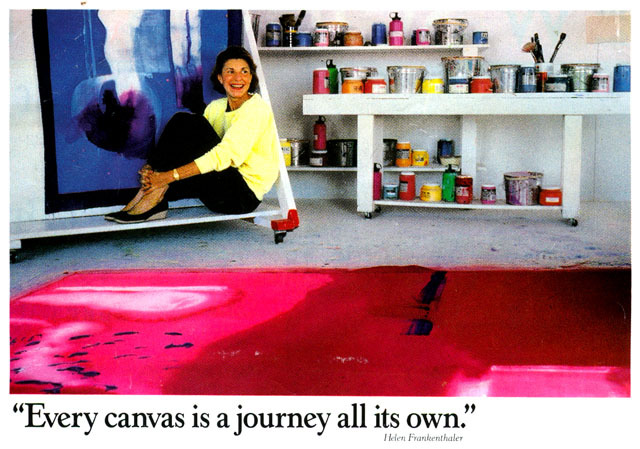During 1956, an Abstract Expressionist painter named Helen Frankenthaler was said to be photographed for LIFE magazine by Gordon Parks. Every lover of the abstract expressionism shall recall about a photograph of Jackson Pollock that was said to be appearing alongside an article in the magazine in 1949, which said: Is he the only greatest living painter coming from the United States?”
Other than introducing Pollock and about the young movement to the popular audience, the LIFE in 1949 did spread an image that talked about Abstract Expressionist would look like in reality. Pollock was depicted to be in a standing position in front of his drip paintings that were present in a pigment spattered type of jacket and found to be smoking a cigarette, wearing a defiant kind of frown.

Untitled, 1962-63
Helen Frankenthaler Foundation
The overall message is very clear; the Abstract Expressionism, which has high hopes of connecting more people with a primal sense of the artistic purpose, is tougher, and complicated men started to pour out their expressive forces in the form of large paintings that had various violent gestures in them. After the year 1952, this type of gestural impulse with the Abstract Expressionism leads to a classification within the Action Painting method.
By being contrasted in the LIFE shoot, Frankenthaler is said to be sitting calm and composed, yet, she is assured with both the legs being politely folded over one another in a button-upped shirt that has been tied into an over-lengthy skirt as a knot. Pollock has been positioned in a way to dominate his own single and hung painting. The Frankenthaler has been surrounded in all possible directions with many of her own paintings being engulfed by the soft swaths kind of paint.

Gordon Parks, Untitled, New York, 1956
Provided with the social climate that highly revolved during the 1950s, a huge difference between both the images of Pollock and Frankenthaler were not able to read as a starkly gendered one. Although the difference between them can be more instructive as of now, the Frankenthaler was said to be notoriously frost in bringing out the gender within the artistic equation. When asked about it during an interview in 1989 for the famous New York Times, she said that there were three different subjects, which she never felt like discussing; one being her former marriage; other about women artists and the final one was about what she thinks about her contemporary works.
During her first marriage that happened with an abstract painter and an art theorist named Robert Motherwell, in the year 1958, the Frankenthaler was already being established as a brand figure among other American art. The process which she made with her art during the early 1950’s, is the one that is referred as self-deprecating ones featuring her mature style, which later one made her one among the most influential artists coming from the mid-century. All those developments were said to be achieved by her after a relationship with a critic named Clement Greenberg, who she met in an exhibition opening in the early 1950s.

Geisha, 2003
Vertu Fine Art
Greenberg made an argument that most of the modern paintings were created as an abstract, mostly a two-dimensional one, and they were created without any kind of narrative or literary content present in them. He even believed that the modern painting must embrace with the present two dimensions and not to attempt them illusionary, like the figurative art. He even went further and made a statement that stated that any kind allusion that is said to be present outside the world shall hinder the psychological and raw emotions in different colours and forms.
For this particular reason, he was said to be an early advocate for Pollock, whose drip kind of paintings was highly challenged with the new idea of representation towards the new degree; by making use of the non-descriptive paint being poured upon the horizontal canvas.
By the year 1952, Greenberg was looking out for the next step that he can reach beyond the normal gestural application with the Abstract Expressionism. Even, Frankenthaler showed him, what she made out of the new pouring method and things that she has developed in the recent days, she even named it as “soak-stain.” Frankenthaler would thin down the oil paints, by making use of the turpentine (which was later on done mixing water with thin acrylics) and pour them all together into the flat canvas that is in broad patches, and by allowing the liquid to immerse with the fibres.
The final image that was obtained, said to be a two-dimensional one and it had more pigments in them, rather than being present in the canvas section. The Mountains and Sea that were created in 1952, was one among her most famous work that simply exemplifies her approach to art. Frankenthaler finished them off, by adding abstract gestures using a charcoal pencil.

Mountains and Sea, 1952
Helen Frankenthaler Foundation
The painting would have become a new game-changer until Greenberg brought in abstract painters named Morris Louis and Kenneth Noland to the Frankenthaler’s studio during the year 1953, and they both said to seize upon her own techniques and the original colours which she created at first instance. Greenberg was even quick to group up the trio with Clyfford Still, Barnett Newman and Mark Rothko, who were artists said to be working on this particular mode, and later on started to highlight the second impulse with the Abstract Expressionism.
Although the early 1950s and 60s were the days, when Frankenthaler reached great heights in terms of popularity, she still remained to be one among the most influential artists coming from the United States, until death called her at 2011. Her way of experimenting on prints and paintings made her turn into a legacy and she became one of the twentieth century’s greatest colourists with a pioneer on pouring new techniques in the state of art.
Without her contribution towards art, it would have been difficult to vision out the sculptures of both Rorschach blot and Lynda Benglish in real. Hommage, a Frankenthaler’s own art was one among the very few people who brought in new innovations upon the table and made herself recognized to become a pioneer in art, even though she was said to be surrounded by male-dominated circles.



What do you think?